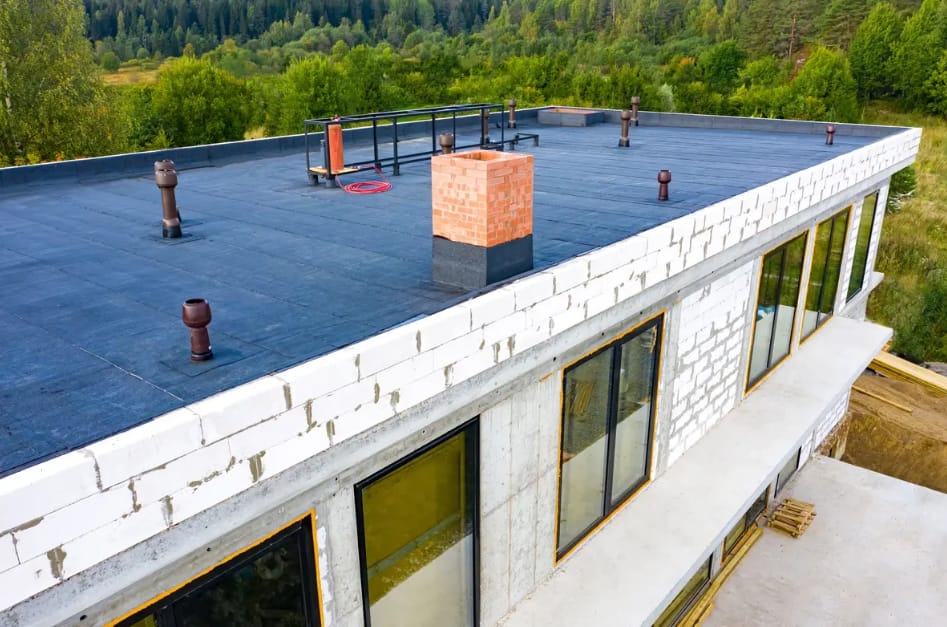For residential and commercial buildings, flat roofs can offer a unique architectural design element. They provide a flexible space that can be used for rooftop gardens, lounging areas, or access to HVAC equipment. If you are going to use your flat roof as a walkable surface then you must select the right material. For, not every type of roofing material is meant to support weight and heavy foot traffic, hence finding a strong, functional, and cost-effective roof material becomes essential.
Thank you for reading this post, don't forget to subscribe!In this guide, we’ll explore five of the best flat roof materials for walking, balancing their pros and cons, as well as practical considerations like durability and maintenance. So stick with me until the end because I want to give you an insight that will enable you to choose the right material for your UK flat roof project with confidence.
Types of Walkable Flat Roofs Materials
Modified Bitumen
Pros:
- What its made of: Plastic, which makes it strong and bendable, so it can withstand low foot traffic.
- In case of minor damage, it is easy to repair.
- Must resist heat, cold and ultraviolet exposure.
- Less expensive than some of the newer materials.
Cons:
- In case of heavy foot traffic, may need extra coatings or walkway pads.
- Shorter service life than concrete and PVC.
- It and certain polyester and vinyls are a bit vulnerable to being punctured if sharp objects or heavy tools are dropped on it.
Walkability:
Modified bitumen is a dizzy step more walkable, especially with the addition of protective layers to it. If you intend to walk on your flat roof only occasionally, for example, when performing seasonal maintenance, this type is the best financial solution.
TPO (Thermoplastic Olefin)
Pros:
- Lite and extremely flexible, ideal for different flat roof structures.
- Energy efficient because reflective surface minimize heat absorption.
- It is resistant to ultraviolet rays, mold, and algae growth.
Cons:
- Heavy, continuous foot traffic can make TPO roofs age faster.
- Wrinkles over time, which can cause uneven walking surfaces.
- That’s because seams can separate, so you need professional installation to prevent that from happening.
Walkability:
TPO is a good option for flat roofs that will see occasional foot traffic. But if something will be used a lot, such as on rooftop patios or gardens, it’s not the most durable material.
PVC (Polyvinyl Chloride)
Pros:
- Very strong, stands up to heavy foot traffic and equipment loads.
- It is resistant to chemicals, grease and oils, which is why it is a popular choice for commercial roofs.
- Long life expectancy and little maintenance.
Cons:
- Costlier than almost all other flat roof material.
- Over time it can become brittle in extremely cold climates.
Walkability:
Another great material for walkable flat roofs is PVC, which is perfect for areas that will have high levels of foot traffic or equipment on these roof surfaces. Suitable for everything from commercial applications to rooftop terraces due to its durability and strength.
Ethylene Propylene Diene Monomer (EPDM)
Pros:
- That’s super resistant to nature’s elements (rain, UV, etc.
- Light. Easy to set up.
- Very flexible, minimizes cracking or tearing.
Cons:
- The rubberized surface might be slick at times, particularly if wet, which can raise safety tips.
- Prone to punctures without mounds of protective layers.
- Short life expectency of just a few days unless event.comm events run frequently.
Walkability:
While EPDM isn’t specifically meant for walking on, it can be made walkable with protective walkway pads or coatings. It’s designed for roofs used occasionally instead of every day.
Concrete
Pros:
- By far the most robust and sturdy option, it can endure heavy foot traffic and furniture.
- With adequate sealing fireproof and durable.
- May be covered with decorative finishes for aesthetic purposes.
Cons:
- Must be professionally installed — with rebar reinforcement.
- Costly at front-end; but long-lasting compensates for the expense in the long run.
- Heavyweight might require some additions in structure support.
Walkability:
Concrete (the flat roof material is the most walkable and other material generally used for rooftop gardens, decks & patio. For a hard-working material that offers amazing looks, concrete is hard to beat.

What to Consider When Selecting Flat Roof Materials
Durability
The durability of materials becomes even more essential if your flat roof will experience foot traffic on a regular basis. PVC and concrete offer outstanding strength, whereas materials such as EPDM and TPO might require additional reinforcement to endure daily use.
Cost
Budget is a huge factor in your material choice. Modified bitumen, meanwhile, is one of the most budget-friendly choices but may need repairs more often. On the other side, concrete involves a high initial investment but provides unparalleled durability and very little upkeep.
Maintenance
Maintaining your flat roof is essential for its longevity. Think about whether the material you select will need to be resealed, repaired or protective-coated often. Some materials such as PVC and concrete require less maintenance than EPDM.
Climate
LOCAL WEATHER CONDITIONS SHOULD GUIDE YOUR DECISION Modified bitumen and TPO work best in moderate environments, while PVC and EPDM excel when extremes are concerned, provided protections are utilized.
Installation and Maintenance Guide
Installation
On up to the on hire does work with experienced contractors to ensure you have efficient installation of your flat roof. Seams that fray or other structural weaknesses can undermine the material’s durability.
Where they fall, it: Reinforce high-traffic areas: Apply walkway pads, tiles, or coatings over EPDM, TPO, or bitumen.
Maintenance
Regular Cleaning: Prevent dirt, leaves and debris from accumulating and causing pooling of water, leading to early deterioration.
Look for cracks, punctures, or uneven surfaces, especially in high-traffic areasInspect Frequently
Reseal as Necessary: Depending on the material, reseal your roof regularly to keep it waterproof and durable.
How to Select the Right Flat Roof Material for You
Most of the best flat roof materials (for walking on) come down to a compromise between cost, durability, and use. Here’s a brief reminder of the best choices:
Modified Bitumen: Cheap and decent for occasional use.
TPO: Lightweight, energy-efficient, and designed for light foot traffic.
PVC: Super durable, perfect for everyday use or equipment places.
EPDM: Good standalone, flexible and weather-resistant but reinforcement better.
Concrete: The most hard-wearing option if you have a rooftop patio or a high volume of foot traffic.
Ultimately, the top material will be one which works with your priorities and budget. When your flat roof is professionally installed, you can rest assured that it will not only perform but that it can also be a safe, functional space for years to come. Select carefully, fit properly, and your flat roof will be a sleek and functional addition to your property.



